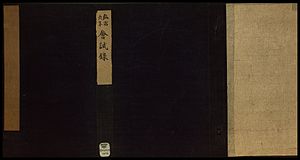
The social structure of China has an expansive history which begins from the feudal society of Imperial China to the contemporary era.[1] There was a Chinese nobility, beginning with the Zhou dynasty. However, after the Song dynasty, the powerful government offices were not hereditary. Instead, they were selected through the imperial examination system, of written examinations based on Confucian thought, thereby undermining the power of the hereditary aristocracy.[2]
Imperial China divided the country into four occupations or classes, with the emperor ruling over them. Throughout this time period, there were attempts to eradicate this system. Social mobility was difficult, or sometimes nearly impossible, to achieve as social class was primarily defined by an individual's identity. To rise required passing a very difficult written exam. The great majority failed, but for those who passed their entire family rose in status.[3]
During the Song dynasty, there was a clear division in social structure which was enforced by law. However, commoners could move up in society through the acquirement of wealth. Through passing the imperial exam or donating resources, people could enter the gentry. By the Yuan dynasty, there was a decrease in protection by the law for commoners. The gentry, however, were given more privileges. The Yuan dynasty also saw an increase in slavery, as the slave status became hereditary. The new policy for commoners at this time also made the various categories within the commoner status hereditary. The Ming dynasty saw a decrease in the number of categories for commoners, in comparison to the policy implemented during the Yuan dynasty. The three categories that remained were hereditary, making it nearly impossible to move between them. Gentry was also divided into two types. By the Qing dynasty, the peasants were seen as the most respected class. Merchants were far lower in status unless they purchased gentry status.
During China's economic reform of 1978, the social structure in the country underwent many changes as the working class began to increase significantly. In 21st-century China, social structure is more reliant on employment and education, which allows citizens to have more social mobility and freedoms.
- ^ Li Yi, The Structure and Evolution of Chinese Social Stratification (University Press of America. 2005) pp 1–55. excerpt
- ^ Nicolas Tackett, "Violence and the 1 Percent: The Fall of the Medieval Chinese Aristocracy in Comparison to the Fall of the French Nobility." American Historical Review 124.3 (2019): 933-937 https://doi.org/10.1093/ahr/rhz317
- ^ Benjamin A. Elman, "Political, social, and cultural reproduction via civil service examinations in late imperial China." Journal of Asian Studies (1991): 7-28. online